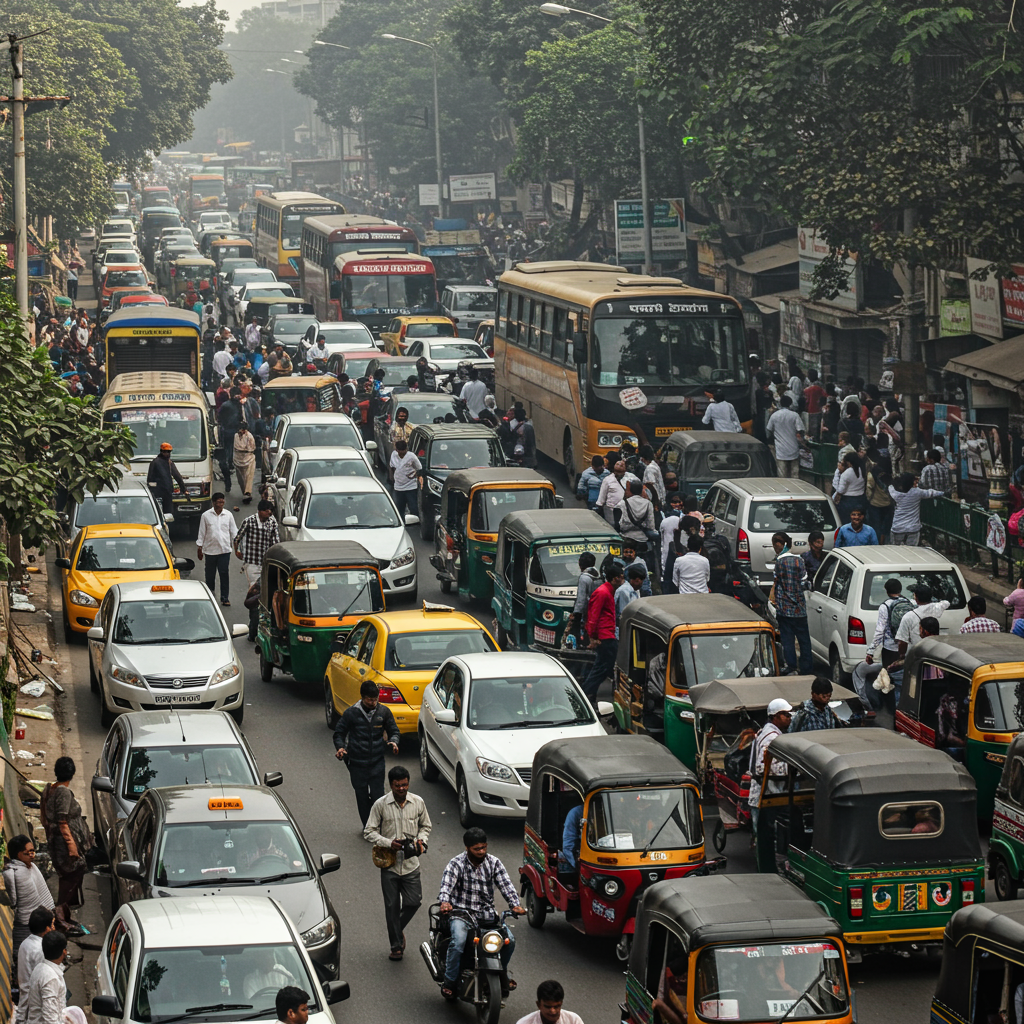Step onto the streets of Mumbai, India, and an overwhelming symphony immediately assaults your senses: the relentless blare of vehicle horns. Far from being a mere backdrop, this cacophony is a defining characteristic of Indian urban life, a pervasive problem that drivers are now escalating by actively seeking out even louder horns. This phenomenon isn’t just an annoyance; it’s a critical public health and safety issue, deeply embedded in the chaotic rhythm of bustling megacities. Explore the reasons behind this deafening trend, its profound impacts, and the challenging search for quiet amidst the din.
The Deafening Reality: India’s Urban Auditory Assault
India’s cities, particularly megacenters like Mumbai, are renowned for their vibrant chaos, but this energy often comes with an auditory price. Noise pollution here isn’t just high; it’s a constant, inescapable presence that permeates daily life. Drivers communicate through a persistent stream of honks, signaling everything from impatience at a traffic light to a simple desire for other vehicles to move. This incessant honking creates a feedback loop: the louder the environment, the louder the horns need to be to cut through the noise.
An informal survey near an NPR bureau in Mumbai once recorded an astonishing 27 honks in a single minute during an afternoon off-peak hour. Traffic constable Vikas Rahane described this as “normal,” yet predicted it would only intensify during peak evening hours, impacting his sleep and causing hearing loss among colleagues. This demonstrates the serious human cost of such extreme noise levels.
Adding to the complexity, laws exist to penalize excessive honking – fines up to $25 in India. However, enforcement remains a low priority for officers like Subhash Shinde, who prioritize maintaining traffic flow and pedestrian safety on Mumbai’s perpetually congested roads. With such challenging conditions, honking violations fall significantly down the list of actionable offenses.
Quantifying the Cacophony: Decibels Beyond Safe Limits
The noise problem isn’t just anecdotal; studies consistently confirm its severity. A 2019 study highlighted that Mumbai’s average noise levels frequently surpass 80 decibels. To put this in perspective, 80 decibels is akin to living with a vacuum cleaner running continuously, day and night. For context, the World Health Organization (WHO) recommends that average environmental noise should not exceed 55 decibels to protect public health. This stark difference underscores the extreme auditory stress experienced by millions daily.
Beyond traffic, the relentless thrum of construction projects — roads, railways, bridges, and housing — contributes significantly to the urban din, often operating around the clock. Sumaira Abdulali, founder of the Awaaz Foundation, a non-profit dedicated to combating noise pollution, points out the ironic truth: while many drivers believe constant honking is essential to navigate, the reality is that “when everyone’s honking no one moves out of your way anyway.” She estimates that vehicle horns can reach an astounding 120 decibels or even higher, a volume level comparable to a rock concert.
Why Louder? The Driver’s Quest for Audibility
The shift towards louder horns is no accident; it’s a deliberate choice by Indian drivers. Many feel that standard vehicle horns are simply inadequate for the chaotic, noisy environment of cities like Mumbai. Drivers frequently express that their default horns fail to grab attention amidst the roar of engines, other horns, and construction.
This perceived need for more impactful sound has given rise to a unique market. Gagan Choudhary, founder of the automobile news website Gaadify, explains that in India, where drivers often chat and play music loudly inside their vehicles, horns with more bass are generally heard more easily. This desire for audibility is a key driver behind the upgrade trend. Vehicle manufacturers themselves are acknowledging this unique demand; some motorbike manufacturers have already increased horn volumes, and car manufacturers are designing horns with a “punchier” bass specifically for the Indian market. Mercedes-Benz, for instance, confirmed that their car horns for India are “slightly adapted for enhanced durability,” recognizing horn usage as an “essential communication tool” in the region.
The Market for Decibels: Upgrading Your Horn in Mumbai
The demand for enhanced horn power has spurred a thriving informal economy. Mumbai’s CST Road marketplace, a bustling stretch packed with automobile spare parts shops, has become a hub for drivers seeking an auditory upgrade. Here, amidst headlights, LED screens, and bumper stickers, shopkeepers offer a dizzying array of horns.
Shop owner Noor Mohammed describes his bestsellers as “titi” horns (flat-toned, popular for bikes and rickshaws) and “pom pom” horns (air-pressure horns favored by SUVs and buses). The “pom pom” variety, in particular, has seen a surge in popularity. Drivers openly admit that “pedestrians don’t listen if you use the ‘ti ti.’ They make way when you use the high-pressure pom pom horns.” Others suggest that some drivers upgrade simply to “show off.”
These aftermarket horns are surprisingly affordable, often costing less than $10 and lasting a year or more, depending on usage. The popularity is so immense that online horn-reviewers have emerged, dedicated to evaluating and recommending specific models. The horn found in the Hyundai Creta, a subcompact SUV, is frequently praised by reviewers for its “very, very, very strong” sound, highlighting the specific qualities drivers prioritize.
Beyond Annoyance: The Grave Consequences of Noise Pollution
While the immediate impact of extreme noise pollution is sensory discomfort, its ramifications extend far deeper, affecting public health, road safety, and overall quality of life. The constant exposure to elevated decibel levels takes a silent but significant toll on the human body.
Public Health and Safety Concerns
Hearing Loss: Traffic police officers, like those mentioned in Mumbai, are on the front lines, suffering direct consequences such as permanent hearing damage. For citizens, prolonged exposure to 80+ decibels increases the risk of noise-induced hearing loss.
Sleep Disruption: The relentless noise, particularly in a city where construction often continues through the night, directly impacts sleep quality. This can lead to chronic fatigue, stress, and reduced cognitive function for millions.
- Stress and Mental Health: Constant exposure to high noise levels is a known stressor, contributing to anxiety, irritability, and even cardiovascular issues over time. The “tragedy of the commons” effect, where individual actions (honking) collectively degrade the environment for everyone, is acutely felt.
- Stricter Law Enforcement: While laws exist, their sporadic enforcement renders them largely ineffective. Consistent penalties for unwarranted honking could gradually shift driver behavior.
- Promoting Civic Sense: This involves a broad cultural shift, encouraging drivers to view honking not as a default communication tool but as a signal of caution, used sparingly and with reason. Public awareness campaigns can play a crucial role in fostering this change.
- www.npr.org
Paradoxically, the very act of installing louder horns, intended to improve road communication and safety, has not translated into safer roads. India tragically records over 150,000 road accident fatalities annually, a grim statistic that continues to worsen year by year. Louder horns have clearly failed to make roads safer, instead contributing to the pervasive noise that may even distract or desensitize drivers and pedestrians. This highlights a critical disconnect between perceived necessity and actual effectiveness.
Seeking Solutions: From Classical Melodies to Civic Sense
The urgency of India’s noise pollution problem has prompted discussions and proposals, though concrete, effective solutions remain elusive. One notable suggestion came from former road and highways minister Nitin Gadkari, who proposed replacing all vehicle horns with sounds of Indian classical instruments, such as the flute, harmonium, or violin. His rationale was to create a “gentler” auditory environment.
However, environmentalist Sumaira Abdulali strongly rejected this idea. She envisioned a chaotic outcome, where “various types of music blaring because somebody is bored or unhappy” would replace the current cacophony with a different, equally disruptive form of auditory assault. Her counter-proposal emphasizes a more fundamental approach: recognizing noise as a serious public health issue.
The Path Forward: Enforcement and Awareness
Abdulali champions two key strategies for combating the noise crisis:
Implementing these solutions in a country with immense population density and complex traffic dynamics presents significant challenges. It requires a concerted effort from government bodies, law enforcement, urban planners, vehicle manufacturers, and, crucially, individual citizens. Until such a widespread shift occurs, the dedicated efforts of activists like Abdulali will continue to echo, hoping to be heard above the incessant din.
Frequently Asked Questions
Why is incessant honking a deeply ingrained practice in Indian cities like Mumbai?
Incessant honking in Indian cities stems from a combination of dense traffic, chaotic road conditions, and a prevailing cultural belief that honking is essential for communication and safety. Drivers often feel standard horns are insufficient to be heard, leading to a feedback loop where louder horns become necessary to cut through the already high noise levels. Enforcement of anti-honking laws is also a low priority for traffic police, further entrenching the practice.
Where can drivers in Mumbai typically purchase and install aftermarket, extra-loud horns?
Drivers in Mumbai commonly find and purchase aftermarket, extra-loud horns at specialized automotive spare parts markets, such as the bustling CST Road marketplace. These shops offer a variety of horns, including popular “pom pom” air-pressure horns, which drivers favor for their louder output. This marketplace acts as a central hub where vehicle owners can upgrade their horns to meet the perceived demands of the city’s noisy environment.
What significant health and safety concerns arise from the extreme noise pollution in India’s urban centers?
The extreme noise pollution in India’s urban centers, often exceeding 80 decibels compared to the WHO’s recommended 55, leads to serious health and safety issues. Key concerns include noise-induced hearing loss, evidenced by cases among traffic police. It also contributes to sleep disruption, chronic stress, anxiety, and potentially cardiovascular problems. Despite the use of louder horns, road safety has not improved, with over 150,000 road accident fatalities annually, highlighting the failure of noise escalation to enhance safety.
Conclusion
India’s honking crisis is more than just a nuisance; it’s a profound challenge to public health, safety, and urban livability. The trend of drivers opting for increasingly louder horns, driven by the perceived necessity to navigate chaotic traffic, only exacerbates an already dire situation. With average noise levels far exceeding global health recommendations, the consequences range from hearing loss and sleep disruption to heightened stress. While proposed solutions, from musical horns to stricter laws, are debated, a fundamental shift in perception and enforcement is desperately needed. Until noise pollution is universally recognized and acted upon as a critical public health issue, the cacophony will continue to define the urban landscape, demanding that we collectively find a way to quiet the streets and foster a more civic-minded driving culture.



